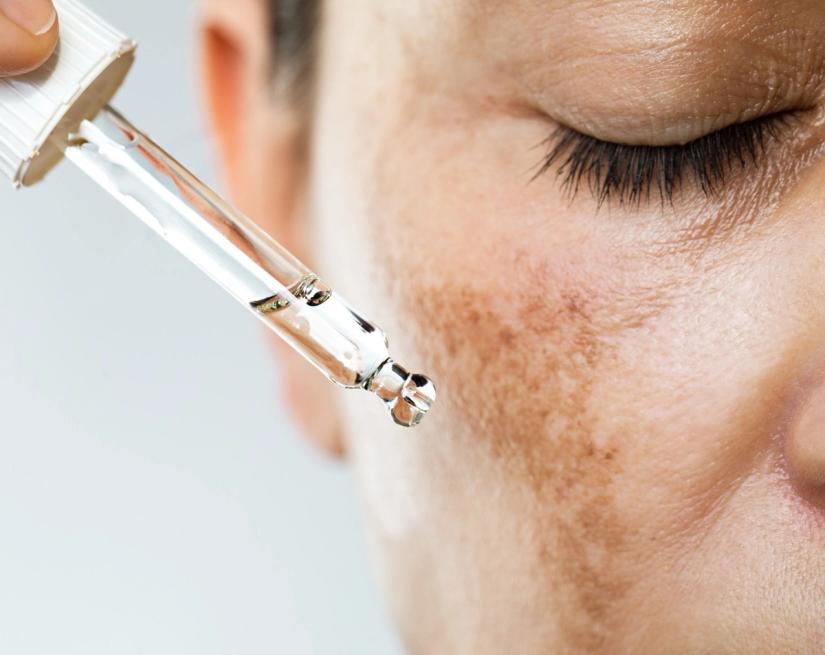Sublime Skin Micropeel Lotion
Exfoliating lotion
skin care
Eve Mérinville | Corporate RD Excellence & SC RD and Innovation Director
10 min read

As you age, you are more likely to develop skin discoloration, or hyperpigmentation, due to sun exposure, hormones, or genetic factors, among other reasons. Skin discoloration on your face can be particularly distressing because of the impact it makes on your appearance, but it can occur anywhere on the body.
Two common hyperpigmentation conditions are melasma and sun spots. But what are these pesky skin conditions, and what can you do about them if they develop?
Keep reading to learn the differences between melasma and sun spots as well as how to prevent and treat them.
"Brown spots are an alteration of the skin metabolism and physiology. The melanin production is activated by the artificial and natural light, to eliminate them we need to constantly protect the skin with a high SPF protection."
Monica Poli - Skin Tech and Device Product Manager
Melasma does not have one specific cause—rather, it’s caused by a combination of genetics, hormonal changes, and sun exposure. You are more likely to develop melasma if you have darker skin or are pregnant. In fact, melasma is sometimes called “the mask or pregnancy” because pregnant people are much more likely to develop it than non-pregnant individuals.
Melasma can develop in either the outermost layer of skin (the epidermis) or the middle layer of skin (the dermis). It can also be present in both layers of skin. In general, epidermal melasma shows the best response to treatment, while dermal melasma does not typically respond well to treatment.
Dark skin patches are caused by an increase in the development of the pigment melanin, which is what colors your skin. For people with melasma, melanin development is increased due to changes in cells from sunlight and hormones which stimulate melanin development.
Melasma is not painful or itchy, and it doesn’t increase your likelihood for skin cancer. However, many people seek treatment for melasma because of the impact it has on their appearance. Melasma is considered a chronic condition because it can persist for months or years in some individuals.

Sun spots, also called age spots or liver spots, are a skin condition caused by overexposure to the sun. They are more common in older individuals, hence the moniker “age spots,” but they can develop in younger people if they do not use adequate sun protection.
Unlike a sunburn, which presents immediately after an overexposure to the sun, sun spots develop slowly over time and may not appear on the skin for years. That’s why it is important to protect your skin from the sun every day, even if you don’t get burned. Daily sunscreen use is an investment in your future skin!
While melasma is most common on the face, sun spots can appear on any part of the body that receives a lot of sun exposure, including the face, arms, and hands. Sun spots develop on the top layer of skin.
Although sun spots can look like freckles, they do not fade naturally after sun exposure ends like freckles do. However, there is some good news—individuals suffering from sun spots can obtain dermatological treatment to lighten or remove them.
Sun spots are not uncomfortable or dangerous, but they do suggest your skin has been overexposed to the sun, which can increase the likelihood of developing skin cancer. Additionally, because sun spots do resemble certain kinds of skin cancer, it’s a good idea to have them evaluated by a dermatologist when they appear.
| MELASMA | SUN SPOTS | |
| Only appears on the face | Can be anywhere on the body | |
| Can be caused by a variety of factors including genetics, hormones, and sun exposure | Are caused by sun exposure | |
| Can be present in multiple layers of skin | Are only present in the outermost layer of skin |

Treatment for melasma and sun spots is similar, although treatment for sun spots is much more likely to be effective than treatment for melasma. Because melasma occurs in deeper skin layers, it is more difficult to treat. Additionally, because melasma forms due in part to hormonal and genetic factors, eradicating it is less straightforward than dealing with sun spots.
| Melasma Treatment | Melasma requires personalized care, as each skin responds differently. Dermatologists often start with topical solutions like hydroquinone creams, sometimes combined with Vitamin C serums to fade dark spots and brighten dull skin. Comfort Zone Vitamin C Booster offers a vegan, natural formula that targets uneven tone and pores. Retinoids are another effective option to slow melanin production and improve skin texture; the Comfort Zone Retinol Booster , enriched with Encapsulated Retinol, Sylibin and Longevity Complex™, visibly renews and smooths the complexion. In more resistant cases, doctors may recommend advanced treatments such as chemical peels or fractional lasers, though these are reserved for severe melasma due to possible side effects. |
| Sun spots treatment | Sun spots are generally easier to treat than melasma since they affect only the skin’s outer layer. Topical treatments like hydroquinone, retinol boosters, or steroids are often effective at fading discoloration. The Comfort Zone Dark Spot Corrector is clinically tested to gently exfoliate sensitive skin and reduce pigmentation, while the Comfort Zone Micropeel Lotion provides gradual exfoliation, brightening uneven tone and preparing skin for further treatments. In more stubborn cases, dermatologists may suggest chemical peels, fractional laser therapy, or dermabrasion, which target hyperpigmented cells but may require multiple sessions and can sometimes cause redness or irritation. |
Unfortunately, the best way to maintain glowy, youthful skin is to prevent hyperpigmentation conditions like melasma and sun spots from occurring in the first place. Although melasma in particular is caused by a combination of factors, there are some best practices that dermatologists recommend to help prevent its development.
First and foremost, sun exposure should be limited as much as possible, since it’s more difficult to reverse sun damage than to prevent it. If you’re in the sun, wear long pants, long sleeves, and a hat that covers your face and neck, if possible.
Additionally, daily sunscreen is a must—and not just for your face! Sun spots can develop on any area of the body, so ensuring that any skin regularly exposed to sunlight is protected by sunscreen is important.
The use of tanning beds is a huge risk factor for developing sun spots and melasma. While it might not appear to impact your skin health, sun spots in particular can take years to develop. Skipping the tanning beds now can help you from getting sun spots as you age.
Finally, since melasma occurs in some patients due to their hormonal makeup, it’s a good idea to avoid the use of oral contraceptive pills if you have a family history of melasma. Any hormonal treatment that involves estrogen (like oral contraceptive pills) will increase your risk of developing melasma.

In most patients, dermatologist intervention and time will decrease, if not completely eradicate, the appearance of sun spots or melasma. To prevent it from developing, protect your skin with sunscreen and other nourishing skin agents like vitamin C and avoid unnecessary sun exposure.
Comfort Zone products can help you reduce the appearance of dark spots and get rid of hyperpigmentation by protecting, nourishing, and exfoliating your skin.
Exfoliating lotion
Brightening serum
Anti-wrinkle serum
anti-aging sun cream
Dark spot correcting serum